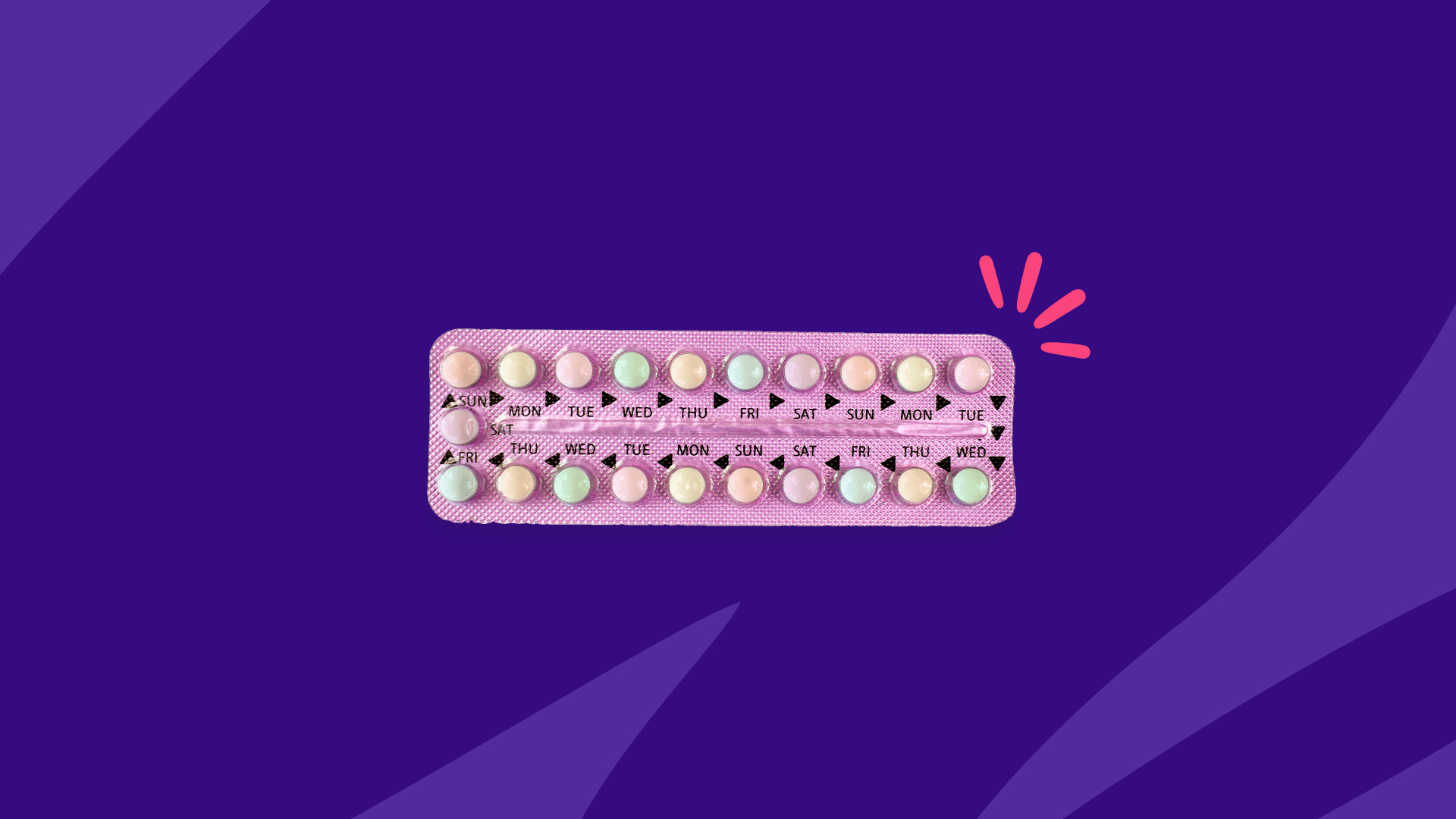If your goal is to prevent pregnancy, oral contraceptives are a safe, effective form of birth control. The pill has other perks too—from improved acne to reduced menstrual cramps and more regular periods. And while it’s one of the easiest methods of hormonal contraception out there, there are many different brands of birth control pills to choose from. Here’s a look at common brands, their effectiveness, and how to choose the right one for you.
RELATED: Birth control options: What’s right for you?
Types of birth control pills
Of all of the kinds of hormonal birth control available, the pill is the most commonly prescribed. In fact, the pill is the preferred method of birth control for 1 in 4 American women between the ages of 15 and 44. Pills work by preventing ovulation (the release of eggs from the ovaries), thinning the lining of the uterus, and thickening cervical mucus. There are three types of birth control pills: combined estrogen-progesterone (combination), progesterone-only (commonly known as mini-pills), and continuous (extended-cycle) pills.
- Combination pills contain both estrogen and progestin (a synthetic form of progesterone) and are taken daily to prevent pregnancy. Most combination pills come in a 28-pack of pills, with three weeks of active, hormone-containing pills and one week of pills with no hormones, but formulations with 24 active pills and four inactive pills (called shortened pill-free intervals are also available. Some packs contain only 21 active pills; a week’s break is taken before starting a new pill pack.
- Progesterone-only pills contain only the synthetic hormone progestin and are taken every day to prevent pregnancy. Progestin-only pills, or mini-pills, come in a pack of 28 pills, but unlike combination and extended-cycle pills, there are no placebo (inactive) pills in the pack.
- Extended-cycle pills, or continuous-use pills, are combination pills that are taken for longer periods of time than the typical 21 days—up to a year without any inactive pills.
According to Dat Nguyen, Pharm.D., a compounding pharmacist and founder of Pharmedico Pharmacy in Sarasota, Florida, the most used types of birth control pills are combination pills and progestin-only pills. The best birth control pill depends on various factors such as the individual’s health condition, age, and lifestyle, says Dr. Nguyen.
To determine the best birth control pill option for you, be sure to consult with your healthcare provider.
RELATED: Birth control statistics
Brands of combination pills
Combined oral contraceptive pills are 99% effective with perfect use (meaning you take the pill at the same time every day and never miss a pill). But when a pill is missed, or other circumstances interfere with perfect use, they are 91% effective.
Combination birth control pills come in five types:
- One-phase (monophasic) pills have the same amount of estrogen and progestin in all active pills.
- Two-phase (biphasic) pills contain levels of hormones that change once during each menstrual cycle.
- Three-phase (triphasic) pills contain doses of hormones that change every seven days.
- Four-phase (quadriphasic) pills contain doses of hormones that change four times each cycle.
- Continuous or extended-cycle pills contain consistent amounts of hormones, so you have few or no periods.
The advantages of combination pills include regulating menstrual cycles, reducing menstrual cramps and acne, and lowering the risk of ovarian and endometrial cancer, says Laura Purdy, MD, a board-certified family medicine physician practicing telehealth in all 50 states based in Nashville, Tennessee. Their disadvantages include potential side effects such as nausea and headaches, she says.
Combination pills can also increase the risk of blood clots, stroke, and heart attack, especially in women who smoke or have other health conditions (like high blood pressure, heart disease, migraines with auras, liver problems, very high cholesterol, a history of blood clots, a history of stroke, or breast cancer), says Dr. Nguyen.
One-phase combination pills include:
- Apri
- Alesse
- Aranelle
- Aviane
- Beyaz
- Desogen
- Estrostep Fe
- Gianvi
- Lessina
- Levlite
- Levora
- Loestrin
- Lybrel
- Lo Ovral
- Microgestin
- Nordette
- Ocella
- Low-Ogestrel
- Ortho-Novum
- Previfem
- Reclipsen
- Safyral
- Yasmin
- Yaz
Two-phase combination pills include:
Three-phase combination pills include:
Four-phase combination pills include:
RELATED: Does birth control cause weight gain?
Brands of minipills
The progestin-only pill is 99% effective if you take it every day. But if you miss a pill, or don’t take it at the same time every day, it’s about 91% effective. The advantages of progestin-only pills include a lower risk of blood clots and stroke than combination pills—making them a safer option for women with certain health conditions (like a history of blood clots or high blood pressure), says Dr. Nguyen.
Progestin-only pills are also safe if you’re breastfeeding. Side effects include nausea, headaches, weight changes, acne, increased hair growth, and breast tenderness.
But the progestin-only pills can also cause breakthrough bleeding and requires strict timing for maximum effectiveness, Dr. Nguyen adds. It’s not safe if you have a history of breast cancer or certain liver tumors.
Available brands of minipills include:
Brands of extended-cycle pills
Extended-cycle pills are combined hormonal pills (which come in 91-day and 365-day options) have the same rate of effectiveness as monthly combination birth control pills (99% with perfect use, 91% with normal use). Their advantages include fewer periods, less menstrual cramping and bleeding, and a lower risk of anemia, says Dr. Purdy.
Extended-cycle pill disadvantages include potential side effects such as headaches, and nausea, she says. They may also cause irregular bleeding and require strict adherence to the extended-cycle schedule, adds Dr. Nguyen. Risks are the same as combination pills.
Brands of extended-cycle brands include:
Birth control pill brands comparison chart
| Brand name | Type | Dose and hormones | Savings options |
| Apri | Combination | 150 mcg desogestrel, 30 mcg ethinylestradiol | See latest prices |
| Aranelle | Combination | 35 mcg ethinylestradiol, 0.5 mg norethindrone | See latest prices |
| Aviane | Combination | 20 mcg ethinylestradiol, 0.1 mg levonorgestrel | See latest prices |
| Beyaz | Combination | 20 mcg ethinylestradiol, 3 mg drospirenone, 0.451 mg levomefolate calcium | See latest prices |
| Kariva | Combination | 20, 10 mcg ethinylestradiol, 0.15 mg desogestrel
(two-phases) |
See latest prices |
| Lessina | Combination | 20 mcg ethinylestradiol, 0.1 mg levonorgestrel | See latest prices |
| Levora | Combination | 30 mcg ethinylestradiol, 0.15 mg levonorgestrel | See latest prices |
| Loestrin | Combination | 20 mcg ethinylestradiol, 1 mg norethindrone | See latest prices |
| Microgestin | Combination | 20 mcg ethinylestradiol, 1 mg norethindrone | See latest prices |
| Ocella | Combination | 30 mcg ethinylestradiol, 3 mg drospirenone | See latest prices |
| Low-Ogestrel | Combination | 30 mcg ethinylestradiol, 0.3 mg norgestrel | See latest prices |
| Reclipsen | Combination | 30 mcg ethinylestradiol, 0.15 mg desogestrel | See latest prices |
| Safyral | Combination | 30 mcg ethinylestradiol, 3 mg drospirenone, 0.451 mg levomefolate calcium | See latest prices |
| Velivet | Combination | 25 mcg ethinylestradiol, 100, 125, 150 mcg desogestrel (three phases) | See latest prices |
| Yasmin | Combination | 30 mcg ethinylestradiol, 3 mg drospirenone | See latest prices |
| Yaz | Combination | 20 mcg ethinylestradiol, 3 mg drospirenone | See latest prices |
| Azurette | Combination | 20, 10 mcg ethinylestradiol, 0.15 mg desogestrel
(two phases) |
See latest prices |
| Mircette | Combination | 20, 10 mcg ethinylestradiol, 0.15 mg desogestrel
(two phases) |
See latest prices |
| Enpresse | Combination | 30, 40 mcg ethinylestradiol, 0.05, 0.075, 0.125mg levonorgestrel
(three phases) |
See latest prices |
| Natazia | Combination | 3, 2, 1 mg estradiol valerate, 2, 3 mg dienogest
(four phases) |
See latest prices |
| Camila | MInipill | 0.35 mg norethindrone | See latest prices |
| Errin | Minipill | 0.35 mg norethindrone | See latest prices |
| Heather | Minipill | 0.35 mg norethindrone | See latest prices |
| Jencycla | Minipill | 0.35 mg norethindrone | See latest prices |
| Nora-Be | Minipill | 0.35 mg norethindrone | See latest prices |
| Seasonique | Extended-cycle | 30, 10 mcg ethinylestradiol, levonorgestrel 0.15 mg
(Active tablet: 84 days; Active ethinylestradiol only (10 mcg): 7 days) |
See latest prices |
| Quartette | Extended-cycle | 20, 25, 30, 10 mcg ethinylestradiol, 0.15 mg levonorgestrel
(20 mcg ethinylestradiol: 42 days: 25 mcg ethinylestradiol: 21 days; 30 mcg ethinylestradiol: 21 days; 10 mcg ethinylestradiol only: 7 days) |
See latest prices |
| Amethyst | Extended-cycle | 20 mcg ethinylestradiol, 90 mcg levonorgestrel | See latest prices |
*Dosage information from Rocky Mountain Health Plans
How to choose a birth control pill
When choosing a birth control pill, it is important to consider factors such as effectiveness, side effects, convenience, and personal preferences, says Dr. Purdy. Your medical history, lifestyle factors, and age should also be taken into account, adds Dr. Nguyen. It’s best to consult a healthcare provider for personalized recommendations, he says.
The most prescribed birth control pill is subjective and can vary depending on location and demographic, advises Dr. Purdy.
The birth control pill with the least side effects can vary depending on your individual needs and preferences says Dr. Purdy. What’s more, some women may tolerate certain brands better than others. That said progestin-only pills are generally associated with fewer side effects compared to combination pills but higher risk of pregnancy.











